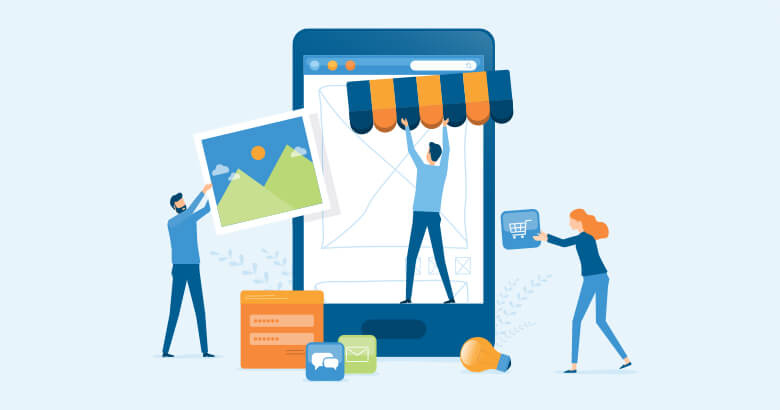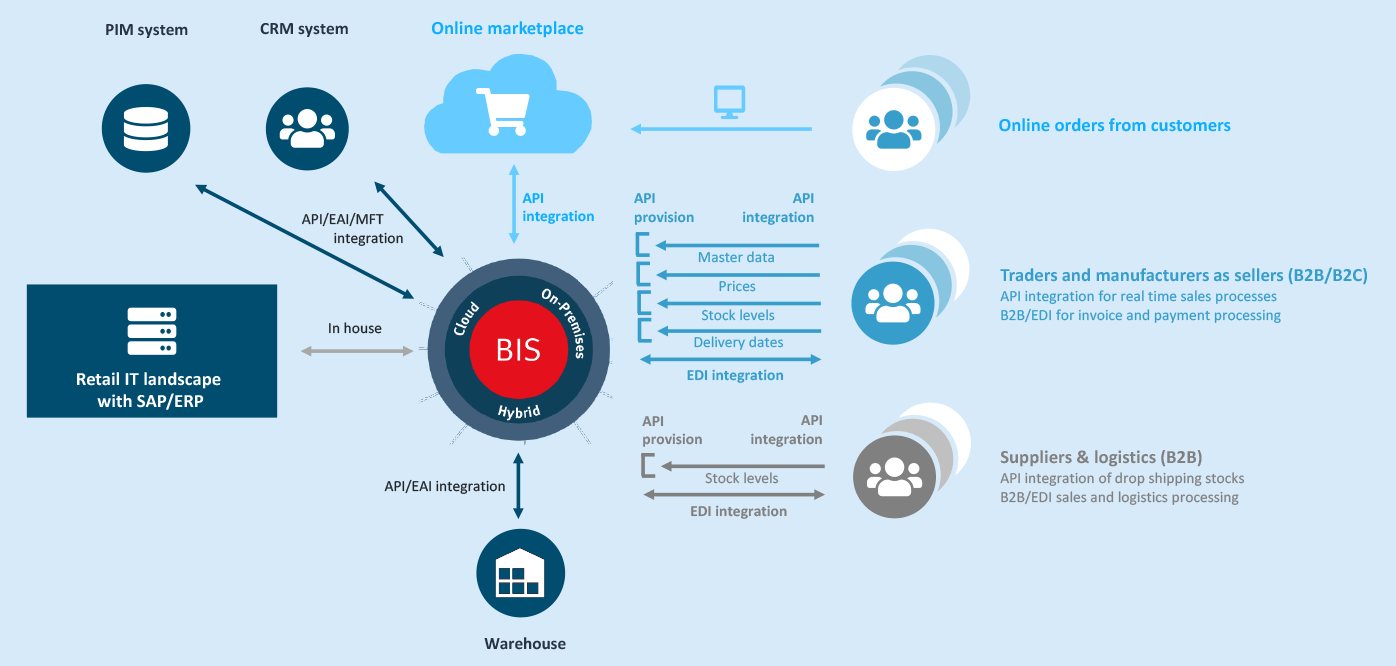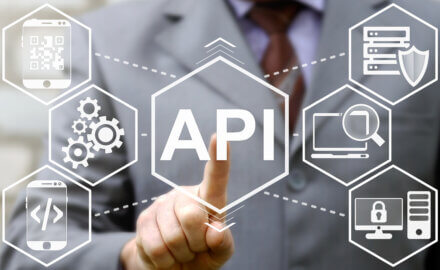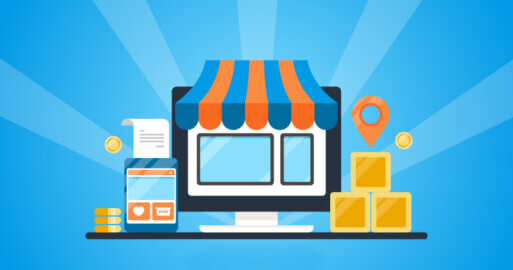Create the Right Technical Foundation for a Powerful Online Marketplace

The Covid pandemic has caused online trade to skyrocket into new dimensions, but also new uncertainties. In order to become or to remain successful, more traders are opening up their established e-commerce platforms as a marketplace for third party offerings. This increases the product range, extends the platform’s range, and ultimately attracts new customers through higher awareness.
However, setting up this new business model presents certain challenges. In your marketplace, there are now several players involved in fulfilling an order. These include your existing suppliers, new, independent sellers, and several logistics providers. As the marketplace operator, it’s your good name that stands for the quality provided by all parties involved. However, third-party providers in particular tend to provide information on availability, price and delivery dates manually, i.e. slowly and unreliably. And this is detrimental to your good reputation.
Only by successfully integrating all parties involved in essential business processes can you provide your marketplace customers with the consistent, high-quality, digital shopping experience they desire.
Automate the processes behind your e-commerce platform with integration software
There are proven methods for seamlessly integrating the various players in the marketplace business. And these will let you meet all requirements while keeping an eye on costs. It starts by digitalizing and automating all processes via a central integration platform.
In order to give your customers the transparency they need on the products in your inventory or from independent sellers, you need access to basic product master data as well as information on availability, prices and delivery times. This should be followed by automated and efficient processes, starting with the ordering, invoicing, payment and delivery.
a) Processes behind your own offerings:
You can usually provide quite precise information on your own product range by directly accessing the relevant systems. These will be PIM software for product master data, an ERP for prices, a WMS for availability or, if you use drop shipping, a supplier’s inventory. These systems can all be integrated by APIs, providing up-to-the-minute information in real time. If you use your own logistics operations, you will know when a product will be delivered. However, it’s also possible to seamlessly integrate an external logistics provider so that you can provide customers with precise tracking for their orders.
If you have your customers’ details in an integrated CRM system, this would let you contact them digitally, in real time yet still GDPR-compliant. You could keep B2C customers updated by e-mail, for example, while carrying out further billing and payment processes via Paypal, or with a debit or credit card. B2B customers on the other hand would be easy to integrate using a combination of B2B/EDI data transfer and APIs.
b) Processes involving third parties:
Some traders – and an increasing number of manufacturers – choose to list their products on industry marketplaces. This is known as D2C, or Direct to Consumer selling. You don’t decide on the terms of these sales. Instead, you pass them on to the customers for reference. However, you could connect to the suppliers‘ systems over defined API interfaces, and receive and publish up-to-the-minute reliable data on prices, stock levels and delivery times. This not only increases your customers’ willingness to buy, but also their long-term satisfaction with the entire marketplace. APIs let you receive a range of information, from master data to prices, stocks and delivery dates. This enables you to give your customers the up-to-date information from third-party sellers that they need to complete their purchase. You determine the design of the secure, synchronous API interfaces, as there are currently no uniform standards for this. This has the advantage that you could automatically connect several partners in real time through a single interface.
Any third-party sellers who work on a commission basis rather than a margin basis can be paid and invoiced using standard B2B communication.
As a rule, you have no direct contact with the logistics providers used by the third-party sellers on your platform. Instead, communications on delivery dates and address details would be between you and the sellers via API. In order to enable faster deliveries, a number of marketplace have set up designated storage areas for third party products, which lets them manage the delivery process and shipment tracking themselves. If, however, a seller uses an independent warehousing or logistics provider, it’s important to make clear who informs the customer of the progress of their delivery. How real-time delivery updates are managed will therefore vary depending on the process behind it. In some instances your third-party sellers will be keeping the customer up to date, while in other instances you will be passing on the data at appropriate times.

Unleash the full potential of your marketplace with the right integration software
Good integration software offers standard Electronic Data Interchange and API functionality on one platform. This lets you follow and support any process and participant you need to at any time. For larger marketplaces in particular, it can feel daunting to connect the sheer numbers of third-party sellers. However, the SEEBURGER community management application (CMA) makes it easy to onboard trading partners through EDI, API and more.
If your company is still relatively new to systems integration, it’s worth searching out an experienced partner to support you with your digitalization. They would be able to advise you on all the ways you could really unleash the potential in your e-commerce activities. You will need:
-
B2B/EDI integration
B2B data transfer with suppliers, vendors and logistics providers for processes such as ordering, invoice and payment. Data transfer occurs along mutually agreed communication protocols and formats in compliance with country and customer-specific requirements.
-
API integration
Use APIs to integrate your marketplace with other applications such as CRM, PIM and warehouse management as well as your ERP system. This way, customers always receive up-to-date data about your retail offers, product availability and delivery times.
-
API provisioning
By providing open APIs, you enable third-party vendors and even dropshipment suppliers to transmit the data your customers need to make a purchase – in real time. You receive the data in a secure and controlled manner, creating a flawless buying experience.
Ideally, your integration software will be cloud-based. The peaks which are so characteristic in marketplaces can be softened by combining cloud-based line-of-business applications with a scalable integration solution. This is your silent, seamless companion, whether as a public cloud setup or from the cloud belonging to a provider such as SEEBURGER. The continuous and automated data flow this ensures makes your business model efficient, resilient and flexible.
Comprehensive integration is a win-win for all in the marketplace business
Ultimately, as the marketplace operator, you are the one who, on the basis of communicated offer data, makes promises to the customer. These are of course based on the data available to you, but need to be kept. Ensure that you have the optimal processes in place to fulfil your own orders. Make integration technologies available to the sellers on your platform for the same purpose. If this is not enough, you may also wish to consider an integrated evaluation system. All in all, integration provides a number of advantages besides automated communication across all processes.
- Higher quality for all the offerings on your marketplace
- Greater transparency through clear and current customer information
- Stronger selling rate for the marketplace
- Speedier selling and shipment processes
SEEBURGER has all the integration patterns you need on one platform and masters all common communication types and formats. Choose the deployment model for your company’s needs, whether an on-premises installation (on a cloud or hardware), all the way to fully-managed cloud services. An established integration specialist, we can support you in procuring suitable solutions and services for your specific needs. The SEEBURGER consultants will be happy to advise you based on more than 35 years of experience in digital B2B trade processes.
Thank you for your message
We appreciate your interest in SEEBURGER
Get in contact with us:
Please enter details about your project in the message section so we can direct your inquiry to the right consultant.
Written by: Patrizia Sauer
Patrizia Sauer has been Business Development Manager at SEEBURGER for CPG/Retail since 2014. She focuses mainly on e-commerce solutions, customer and partner support in this environment, and innovations for the digitalization of functional and technical business processes. Ms. Sauer is a manager of industrial engineering specializing in online sales & marketing, and has multiple years of professional experience in the software industry and digital trade, having worked for seven years prior thereto at Amazon EU.





